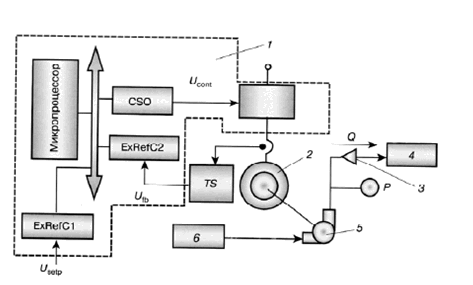Rational power consumption, and hence energy saving, is ensured not only by the economical use of electricity by consumers (in particular, by electric drives), but also depends on the quality of electricity in the supply network. The quality of electricity is assessed by the following indicators [1].
For three-wire networks of three-phase current, the permissible values of voltage and frequency deviations are normalized, as well as the characteristics of voltage unbalance industrial frequency and non-sinusoidal voltage waveform. Frequency tolerance, i.e. the difference between its current and nominal values at a slow change is limited to values of ± 0.1 Hz. Fluctuations frequency, i.e. its rapid changes are limited to 0.2 Hz in excess of the permissible value of its deviation. These standards refer to the nominal operating conditions. Power supply systems and do not apply to the post-emergency period.
Permissible values of voltage deviations from the rated voltage at the terminals of electric motors under the conditions of normal start-up and control should be within the range of -5 … + 10%. Additional voltage drop in post-emergency modes is allowed by no more than 5%.
Currently, about 70% of the generatedelectric energy in the Republic of Uzbekistan they are consumed by electric drives of various technological machines and mechanisms for industrial, agricultural and household purposes. The vast majority of industrial and agricultural production plants operate from 0.4, 6 and 10 kV asynchronous electric motors, for example, about 8-10 billion annually in the Republic of Uzbekistan kW of electric energy is consumed by pumping units based on asynchronous electric drives operating in various regions of the country. Due to the underutilization of general industrial mechanisms (pumping units, compressor units, fans, smoke exhausters, etc.) in the overwhelming majority of cases, their average load is 30-60% of the nominal value, as a result of which there is an unreasonable consumption of energy from the network of active and reactive power. At the same time, the technical, economic and energy indicators of general industrial mechanisms are significantly reduced, and the specific consumption of electrical energy per unit significantly increases manufactured products. The physical basis of the solution suppliedthe task is to ensure the work asynchronous motor providedminimum current, that is:
![]()
where ![]() is the relative current in the stator winding;
is the relative current in the stator winding;
![]() - effective and nominal valuescurrent;
- effective and nominal valuescurrent;
![]() - relative flow in airengine clearance;
- relative flow in airengine clearance;
![]() - effective and nominal valuesmagnetic flux.
- effective and nominal valuesmagnetic flux.
The real range of engine load is within 0.3Rn (where Rn is the rated engine power). It is known from the magnetization curve that within these limits of the region of the magnetization characteristic
linear dependence is approximated, that is
![]()
Then, without prejudice in equation (1), the flux is replaced by the voltage
![]()
where ![]() is the relative voltage engine.
is the relative voltage engine.
Development, creation and implementation of energy-saving technologies in production, in accordance with the customer’s requirements, includes the development of technical specifications and regulatory documentation, production and testing of energy-saving samplestechnologies, preparation and development of production.
Implementation of the proposed energy-saving system will improve the energy performance of technological machines as a whole. By minimizing the power consumption of the drive, the maximum values of efficiency and power factor are achieved equipment at various operating modes and loads of mechanisms Fig.1

Fig 1. Functional diagram of an energy-saving automated electric drive based on a pumping unit:
1. Saving in active power is average 10%.
2. Savings in reactive power – on average thirty %.
3. Soft start with a decrease in starting current in 2-3 times.
4. Reducing power consumptionelectric motor due to soft start in 3-4 times.
5. Reduction of dynamic impacts by 2-3 times.
6. Improving operational reliability in 1.5-2 times.
References
- Хашимов А.А., Мирисаев А.У., Кан Л.Т. «Энергосберегающий асинхронный электропривод» Т.: Fan va texnologiya, 2011, 133 с.
- Патент РУз IAP035214 от 23.10.2007 «Асинхронный электропривод» (патентообладатель Хашимов А.А.)

 View this article in Russian
View this article in Russian